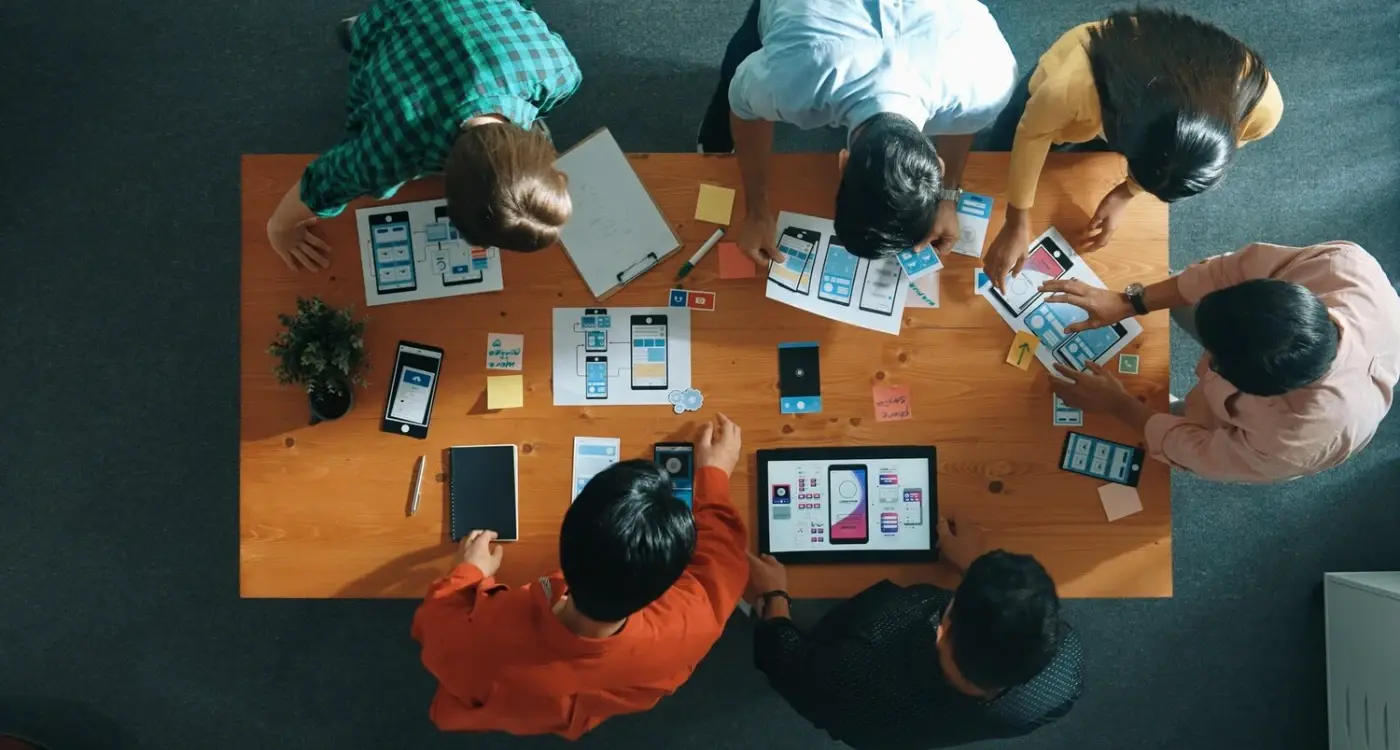What Role Should You Play As A Client In Agile App Development?
Picture this: you've just hired a brilliant development team to build your mobile app, handed over the brief, and now you're sitting back waiting for the magic to happen. Three months later, what arrives isn't quite what you had in mind. Sound familiar? This scenario plays out more often than you'd think, and it's not because the developers aren't skilled—it's because clients often don't understand their role in the development process.
Agile development has transformed how we build mobile apps, but here's the thing—it only works when clients roll up their sleeves and get properly involved. Gone are the days when you could disappear after the initial meeting and expect perfection to emerge from the development cave. Modern app development thrives on collaboration, quick decisions, and constant feedback loops.
The best mobile app projects I've worked on have always had one thing in common: clients who understood that their participation wasn't optional, it was the secret ingredient that made everything work
This guide will walk you through exactly what that participation looks like in practice. We'll cover everything from setting clear expectations to providing feedback that actually helps your development team build something brilliant. Because when you get agile participation right, project collaboration becomes less about managing chaos and more about creating something truly special together.
Understanding Your Active Role in Agile Development
Right, let's get one thing straight from the start—agile development isn't something that happens to you as a client. You're not just sitting on the sidelines waiting for your app to magically appear. You're part of the team, and frankly, you're one of the most important parts.
I've worked with hundreds of clients over the years, and the successful projects always have one thing in common: the client understands they need to roll up their sleeves and get involved. Agile development works in short bursts called sprints—usually two to four weeks long. During each sprint, your development team builds specific features, tests them, and shows you the results.
What This Means for You
Your job isn't to disappear for three months and come back expecting a finished app. You'll need to be available regularly to make decisions, review progress, and provide feedback. Think of it this way: your development team knows how to build apps, but only you know what your business needs.
The Key Responsibilities You'll Have
- Reviewing and approving features as they're built
- Making decisions quickly when the team hits roadblocks
- Testing new features and reporting any issues
- Clarifying requirements when something isn't clear
- Prioritising which features matter most to your users
The beauty of agile is that you get to see your app taking shape bit by bit. You can spot problems early, suggest improvements, and make sure you're getting exactly what you need. But this only works if you're willing to be an active participant rather than a passive observer.
Setting Clear Expectations and Goals
I've worked with hundreds of clients over the years, and the ones who get the best results from their mobile app projects are those who know exactly what they want before we start coding. Not the colour of the buttons or the fancy animations—that stuff comes later. I'm talking about the big picture stuff that really matters.
Your development team needs to understand what success looks like for your app. Is it about getting 10,000 downloads in the first month? Maybe it's about reducing customer service calls by 30%? Or perhaps you want users to spend at least 5 minutes in the app per session. Without these clear targets, your team is basically building blind.
What Your Team Actually Needs to Know
Here's what I always ask my clients to nail down before we start: who will use this app, what problem does it solve for them, and how will we measure if it's working? Sounds simple, but you'd be surprised how many people skip this step. The agile participation process works best when everyone knows the destination.
Your goals should be specific and measurable. Instead of "I want lots of users," try "I want 5,000 active users within 3 months." This gives your team something concrete to work towards and helps with project collaboration throughout the development process.
Write down your top 3 goals and share them with your development team before the first sprint begins—it'll save you weeks of back-and-forth later.
Communication That Keeps Projects Moving
I'll be honest with you—most app development projects that go wrong do so because of poor communication. Not because the developers aren't skilled or the client doesn't know what they want, but because both sides aren't talking to each other properly. In agile development, communication isn't just nice to have; it's what keeps the whole thing from falling apart.
The beauty of agile is that it's built around regular check-ins and conversations. You're not waiting months to see what's been built—you're having daily or weekly chats about progress, problems, and priorities. But here's the thing: these conversations only work if you show up and engage properly.
Making Communication Work Both Ways
Good communication in agile development means being available when your team needs you and asking questions when you don't understand something. Don't wait for the weekly meeting to mention that big concern you've been thinking about—bring it up straight away. Your development team can't read your mind, and they can't fix problems they don't know exist.
The Tools That Keep Everyone Connected
Most agile teams use a mix of communication tools to stay connected:
- Project management platforms like Jira or Trello for tracking progress
- Slack or Microsoft Teams for quick daily conversations
- Video calls for sprint reviews and planning sessions
- Email for formal documentation and sign-offs
The key is responding quickly when your team reaches out. If they're stuck waiting for your input, the whole project slows down—and that costs everyone time and money.
Making Quick Decisions When Development Teams Need Them
I've seen countless mobile app projects grind to a halt because clients couldn't make decisions quickly enough. The development team is ready to move forward, but they're waiting for approval on a feature, a design choice, or a technical direction. Days turn into weeks, and suddenly your sprint timeline is completely off track.
In agile participation, speed matters more than perfection. Your development team will present you with options and they need answers—not necessarily the perfect answer, but a clear direction they can work with. This doesn't mean making reckless choices; it means understanding that most decisions can be adjusted later if needed.
Setting Up Decision-Making Systems
The smartest clients I work with establish decision-making frameworks before development even starts. They designate who has authority to approve what, set response timeframes for different types of decisions, and create backup plans when key stakeholders aren't available.
The best project collaboration happens when clients treat decisions like building blocks rather than permanent fixtures
Remember that agile development is designed to be flexible. That design element you're unsure about? The team can build it, test it, and refine it in the next sprint if needed. Your job is to keep the momentum going while staying true to your app's core vision.
Providing Feedback That Actually Helps
Getting useful feedback from clients is like finding gold dust—it's rare and incredibly valuable when you get it right. After working with hundreds of clients over the years, I can tell you that the difference between good feedback and bad feedback can make or break a project timeline.
The secret lies in being specific rather than vague. Instead of saying "I don't like how this looks," try "The blue header feels too dark and makes the white text hard to read." See the difference? One gives the development team something concrete to work with; the other leaves them guessing what's wrong.
Focus on the User Experience
Think about your app from your user's perspective when providing feedback. Comments like "My customers won't understand this button" or "The checkout process takes too many steps" are gold. They help developers understand not just what to change, but why it matters.
Be Quick but Thoughtful
Agile development moves fast, so your feedback needs to keep up. But don't rush so much that you miss important details. Take time to test the feature properly—click all the buttons, try different scenarios, use it like a real customer would. The development team would rather wait an extra day for thorough feedback than receive rushed comments that miss the bigger picture.
Testing and Reviewing During Development Sprints
Right, let's talk about one of the most important parts of mobile app development that clients often get wrong—testing during sprints. I've seen too many projects where clients wait until the end to start testing, and trust me, that's a recipe for disaster. In agile development, testing isn't something you do at the end; it's something you do throughout each sprint.
When your development team delivers a build for testing, they need your feedback quickly. We're talking days, not weeks. The whole point of agile participation is that you're actively involved in spotting issues before they become bigger problems. Test the features as they're built, not when the entire mobile app is complete.
What to Look For During Testing
Focus on the user experience first—does the app feel right when you use it? Are the buttons where you expect them to be? Does the flow make sense? Don't get caught up in minor visual tweaks during early testing phases. Save those for later sprints when the core functionality is solid.
Set aside specific time each week for testing. Put it in your calendar and treat it like any other important meeting. Your development team is counting on your input to keep the project moving forward.
Remember, effective project collaboration means being available when your team needs you most. Testing during sprints is one of those times where your involvement directly impacts the success of your mobile app.
Managing Changes and New Requirements
Here's something I've learnt from working with clients over the years—changes will happen. Not might happen, will happen. And that's actually fine! The whole point of agile development is to handle these changes smoothly without derailing your project.
The key is knowing when to say yes and when to pump the brakes. Not every shiny new idea needs to make it into your app, especially if you're halfway through development. I've seen projects balloon from simple concepts into complex monsters because clients kept adding "just one more feature" every week.
Smart Ways to Handle Changes
When you do need to make changes, timing matters. Here's how to approach it:
- Wait for natural sprint breaks rather than interrupting mid-sprint
- Discuss the impact on timeline and budget upfront
- Prioritise changes that affect core functionality first
- Document why the change is needed—this helps everyone understand
- Consider whether the change can wait for a future version
Remember, your development team isn't trying to be difficult when they explain why a change might be complex. They're helping you understand the technical implications so you can make informed decisions about your app's future.
Conclusion
After working with hundreds of clients over the years, I can tell you that the most successful mobile app projects are the ones where clients embrace their role as active participants rather than passive observers. The days of throwing requirements over the wall and waiting for magic to happen are long gone—agile development needs you to be present, engaged, and ready to make decisions when your team needs them.
Your involvement in agile participation isn't just helpful; it's what separates apps that launch successfully from those that struggle or fail completely. When you communicate clearly, provide timely feedback, and stay flexible with changing requirements, you're not just being a good client—you're becoming a vital part of the development process itself.
The mobile app market is more competitive than ever, which means project collaboration between you and your development team can make or break your app's success. Teams that work well together build better products, launch faster, and create apps that users actually want to use. Your active participation transforms what could be a frustrating back-and-forth process into a smooth, efficient journey towards your app goals.
The role you play as a client shapes every aspect of your app development experience. Choose to be engaged, responsive, and collaborative—your app (and your development team) will thank you for it.
Share this
Subscribe To Our Learning Centre
You May Also Like
These Related Guides

How Do I Get Everyone to Want the Same App Features?

What's The Difference Between Scrum And Kanban For Mobile Apps?



